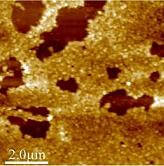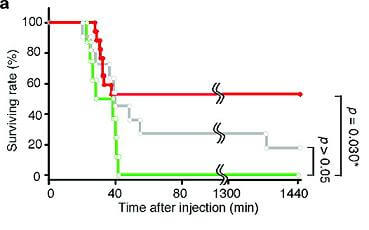
Researchers in Japan and California (Stanford, UC Irvine) have developed plastic antibodies capable of seizing and neutralizing dangerous materials in the body. The polymer nanoparticles were injected into live mice after they had been subjected to melittin, the toxin in bee venom. The nanoparticles captured the melittin and carried it to the liver for destruction. As reported in the Journal of the American Chemical Society, nearly 60% of mice treated with the plastic antibodies survived compared to 0% of mice who were injected with just bee venom. I was able to talk briefly with Professor Kenneth Shea at UC Irvine about the experiment and this is the first time such techniques have been used in living animals. The plastic antibodies could eventually be shaped to capture many different antigens including viruses and proteins. In my view, these polymer nanoparticles may be the first step in building an artificial immune system in humans to augment our natural one.
Regenerative medicine may have the potential to regrow organs, or even fight the effects of aging, but it’s nanotechnology that holds truly mind-blowing promise for our bodies. We’ve already seen how Dendreon (with Provenge) has essentially turned the human immune system into a nanotechnology by training it to fight prostate cancer. Now the researchers in the plastic antibody project are providing an artificial expansion of the immune system. While the body naturally forms antibodies to many toxins, the polymer nanoparticle approach let’s us develop synthetic antibodies before we are ever exposed to a substance. Almost any molecule has the potential to be targeted by these plastic antibodies, letting us augment our immune systems for almost any toxic situation. Eventually, this nanotechnology will be joined by others that augment the way we deliver oxygen and food to our cells, regulate our temperatures, and repair damaged tissue. Nanotechnology may one day provide our bodies with unbelievable resilience and longevity.

Yet the plastic antibodies created at UC Irvine are still relatively simple forms of nanotech. In fact, you can think of them as plastic molds. Monomer particles and the melittin toxin were mixed together and the monomers formed a sort of cast around the toxin. The toxin was then removed through dialysis, leaving empty cavities where it once resided. This process, called molecular imprinting (MIP), produces the polymer nanoparticles that have exactly crafted holes for the toxin they were designed to capture. This allows these plastic antibodies to bond to those toxins (such as melittin) but not otherwise interfere with the body.
The research team tested the biocompatibility for the plastic antibodies by exposing them to mice cells in vitro. When that proved successful, they proceeded to test the nanoparticles in live mice. Two weeks after injection the mice hadn’t lost weight and maintained healthy tissues, demonstrating that the plastic antibodies were non-toxic (at least in the short term).
Once the polymer nanoparticles were deemed safe for trial, researchers proceeded to test their efficacy. As mentioned above, mice were injected with bee venom (melittin), the toxin for which the batch of plastic antibodies have been molecularly imprinted. 20 seconds later, mice received either the imprinted antibodies, non-molecularly imprinted antibodies, or nothing. The size of each group was about 30, and several rounds of testing occurred. Mice who received nothing always died (now I know who to bet on in a bee vs. mouse battle). Molecularly imprinted nanoparticles allowed nearly 60% of injected mice to survive. That’s pretty good evidence that the plastic antibodies are doing their job well.

Curiously, some mice injected with non-imprinted nanoparticles also survived. You can see in the graph from the report in the JACS that more than 20% such mice lived for some non-trivial period of time. Yet the report states: “In contrast, [non-imprinted nanoparticles] did not significantly neutralize melittin in vivo.” According to Shea, mouse studies have a complex statistical analysis system surrounding them, dictating what is ‘significant’ or not. This was not Shea’s area of expertise (his Japanese collaborators handled that analysis) so he wasn’t able to clarify further. This isn’t really a big deal, it doesn’t detract from proving the efficacy of the imprinted nanoparticles, but I thought I would point it out anyway. Science is more fun when it’s slightly confusing.

Further research into the plastic antibodies is moving forward as Shea and his team form new collaborations to pursue various applications for the technology. According to the professor, Melittin was used as a sort of ‘poster-child’ for more serious toxins – everything from more potent insect and snake venoms to the toxic secretions of microorganisms. The next round of research may include molecularly imprinted nanoparticles targeting some of these substances. Shea also mentioned that the technology may be used in non-immune system applications like protein purification and diagnostics. The UC Irvine Office of Technology Alliances is handling the potential intellectual property concerns, and patents may be announced at some point in the future.
Anytime we see a successful application of nanotechnology, I get very excited. Like artificial intelligence and genetics, nanotech is likely to be one of the definitive technologies of this century. The plastic antibodies, with the potential to target many different toxic molecules in the body, have a huge potential. Yet we should keep in mind that this research is still in very early stages. Animal models are not human trials, and it will be many years (at least) before medical therapies could be developed. Futhermore, plastic antibodies (as they are now) cannot report back to the immune system like natural ones, nor can they replicate themselves (again, at least not for now). Eventually, however, I think nanotechnology will be able to augment our systems, providing amazing benefits beyond what we possess today. I look forward to the day when blood-borne nanoparticles allow me to laugh away the dangers of bee stings. I’m going to call that day “Free Wild Honey Day” and it is going to be awesome.
[image credits: Hoshino et al, JACS 2010]
[source: Hoshino et al JACS 2010, Kenneth Shea]


